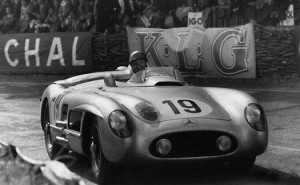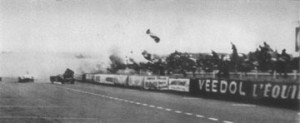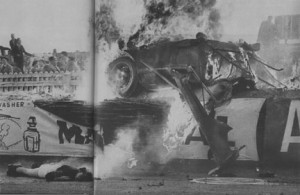Le Mans 1955: A Day of Tragedy

Five-time F1 Champion Juan Manuel Fangio was able to narrowly avoid disaster during the horrible accident at the 1955 24 Hours of Le Mans.
The element of danger in sports is like a wedding ring: always present, a constant reminder of commitment, passion…and eternity. All too often that tantalizing element has come calling, then taking the heroes we thought were invincible. On rare, regrettable occasions, danger spreads its cloak beyond the field of play to encompass even the spectator. This is an account of one such tragedy.
The Course
June 11, the 1955 24 Hours of Le Mans at the famous 8.38 mile track outside the French town of Le Mans. Traffic moves in a clockwise direction with the pits and infield being on the driver’s right and the grandstand and spectators on the left.
The Principals
Mercedes, Jaguar, Ferrari, Aston Martin and Maserati were the fierce competitors of the era. Daimler-Benz (Mercedes) had three of their new ultra-light 300SLR cars in the race. The formidable team of five-time F1 World Champion Juan Manuel Fangio and the legendary Stirling Moss were favored to win it for Mercedes. Another Benz car featured the team of Frenchman Pierre Levegh and the American, John Finch.
Jaguar was up to the challenge with the team of Mike Hawthorn and Ivor Bueb in their D-type.
Lance Macklin, driving an Austin-Healey 100, was the man “caught in the middle” when all hell broke loose.
The Race
Just prior to the catastrophe, this was the situation on the course: over two hours into the race, on lap 35, Hawthorn in his Jag D-type was leading by a few lengths. His crew signaled him into the pit. Fangio, in the 300 SLR, was not far behind in second position.
Levegh’s already-lapped Mercedes was between Fangio and Hawthorn and Macklin’s weak Healey loomed ahead of Hawthorn as the pits approached on the right.
Disaster
Hawthorn easily passed Macklin and then had to slow quickly to exit into the pit area. Meanwhile, Fangio was preparing to pass his stable mate, Levegh.
The state-of-the-art disc brakes on Hawthorn’s Jaguar smartly slowed him for the pit stop. The sudden braking caught Macklin by surprise and he swerved his Austin-Healey to the left to avoid contact.
Levegh and Fangio, nearing pit row, were bearing down in their own private battle of wits.
As Macklin veered into center track, Levegh raised a hand to signal Fangio of impending disaster ahead. The slower-responding, inadequate drum brakes on the 300SLR were of no help. At 140 mph, it was too late to avoid a collision.
Levegh’s Mercedes literally drove up the ramp-like rear body of the Healey and launched itself skyward, landing on an earthen berm near the spectators. Sheer speed and centrifugal force sent the spinning mass of metal and man into several somersaults, flinging driver and car parts asunder.

After the Mercedes struck the retaining wall, the engine plowed straight into the crowd.
The front axle and engine block were ripped from their mounts and hurled into the shocked crowd. The fuel tank ruptured and the magnesium alloy body ignited into a white-hot inferno. Secondary explosions sent the burning debris over the scattering race fans.
Levegh was killed instantly. His skull was crushed in the nightmarish maelstrom.
Meanwhile Fangio was able to avoid the careening Austin-Healey as it crashed first into the pit wall then bounced back across the track, ironically coming to rest near the flaming carcass of Levegh’s race car.
Although Macklin walked away, a bystander was killed as his car impacted the berm.

83 people, including both spectators and drivers, were killed in the worst accident in motorsports history.
Firefighters, un-trained in the volatile flash properties of magnesium, tried to douse the flames with water. The pressurized streams from their hoses only scattered the still-burning remnants of the Mercedes’ body over the panicked crowd.
The race continued on, as track officials tried to keep the paths of ingress and egress open for the inevitable army of ambulances.
As the death toll mounted throughout the day and into the night, orders came down from Mercedes-Benz in Stuttgart to pull the remaining two 300 SLRs from the race out of respect for the victims. The Fangio/Moss Mercedes was leading by a lap over Jaguar at the time.
The team of Hawthorn/Bueb continued racing, eventually winning for Jaguar, although it was a bitter and hollow victory.
Aftermath
The final number of confirmed deaths was 83. It was the worst catastrophe in motor sports history. No person or team was found to be responsible for the disaster. It was ruled a “racing incident”.
Track design and inadequate safety standards were blamed for the death of the spectators. Motor sports were voluntarily banned in several countries until safety standards were heightened.
Mercedes-Benz won the two remaining events of the 1955 season and then submitted to a self-imposed ban on circuit racing, which lasted into the 1980s. German engineering and racing technology were at that time without parallel.
One can only wonder how the landscape of motorsports might have differed had Daimler-Benz stayed on…
Post mortem
Pierre Levegh was not considered a dominant driver. His claim to fame before the tragedy came in the 1952 Le Mans, when he drove for 23 straight hours. He was leading the race going into the last hour, when due to fatigue, he missed a gear, causing an engine failure and the resulting DNF(did not finish).
As a young man, he was considered a world class athlete in ice hockey and tennis. He died racing, at the age of 50. His final act of sportsmanship (raising a hand of warning) probably spared the life of his fellow driver, Juan Manuel Fangio.
As a result of this horrifying tragedy, the more efficient disc-braking technology came into an almost exclusive use in motorsports racing.
In a moment of cruel irony, Pierre Levegh had declared just before the race, “We need a signal system. Our cars go too fast.”
Just to clear up one piece of mis-information: while the Mercedes lacked the stonger and more efficient disk brakes of the Jaguar, they more than made up for that by having a unique aero-brake system that added a foil to the rear of the car. A lever on the dash operated the foil and it could slow the car dramatically when needed, without locking up the wheels. Unfortunately, Levegh probably never got used to the aero brake, while Fangio and Moss did.
My neighbor and I were just debating this particular topic, he’s usually seeking to prove me incorrect. Your view on that is great and exactly how I actually feel. I simply now mailed him this website online to point out him your individual view. After trying over your website I ebook marked and will probably be coming again to learn your new posts!
How come you do not have your web site viewable in mobile format? Can not view anything in my netbook.
Triste día para el automovilismo, y una de las peores tragedias mundiales del deporte donde fallecieron tanto el piloto como un gran número de inocentes espectadores.
invented the burning of a fast racing car huh? hopefully it can be our reminder to always be careful and pray